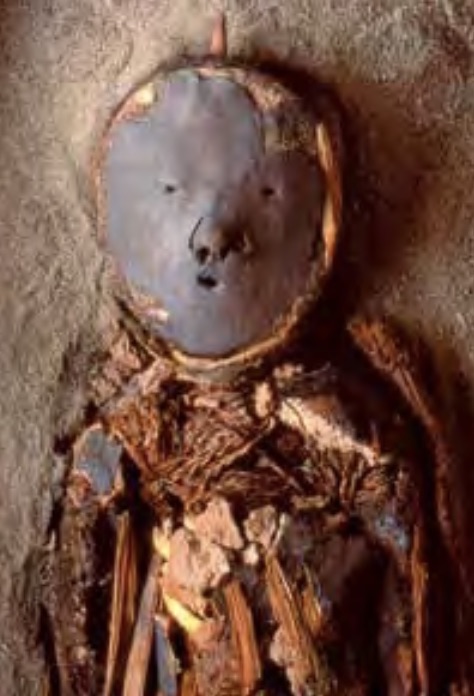
The Chinchorro mummies are the oldest mummies in the world, part of the preceramic Chinchorro culture. The mummies demonstrate a high level of complexity in pre-modern societies. Unfortunately, there is no writing so most of the knowledge is based on archeological findings.
The Chinchorro culture occupied northern Chile and southern Peru around 9,000 BP. They were adept in their living conditions, living in one of the driest places on earth, the Atacama Desert. They were a fishing and hunter-gather community. Their mummification began around 7,000 BP and stopped around the first century BCE, although their practices would continue in other cultures, such as the Inca.
The Chinchorro people practiced elaborate mummification 2,000-3,000 years before the Egyptians. It was a complex process that consisted of removing all the organs and replacing them with “clay, mud, sticks, llama fur, and plants” (Hutchison 68). They were colored with black manganese or red ochre and adorned with facial masks, helmets, or wigs with human hair. Unlike other cultures where mummification was preserved for only those at the top of the social hierarchy, Chinchorro mummification took place with no importance to social rank. Therefore, researchers have recovered numerous mummies that people of other cultures typically do not mummify, such as children and fetuses. The mummies were both artistic and religious objects, holding an aesthetic and spiritual value. The creators paid great attention to detail and their use of advanced technology aided in their preservation. Modern researchers view the mummies as an aesthetic expression of the body with their elaborate decoration, calling them “masterpieces of human creative genius” (UNESCO 198).
Today, the Chinchorro mummies are available to us today as the arid climate greatly contributed to their preservation. The mummies represent some of the most intricate mortuary practices, representing high “cultural, technological, and artistic value” (UNESCO 198). They show the complexity of early societies and that pre-contact Chile was a more diverse and complex place than earlier researchers may originally have thought.
Works Cited:
Hutchison, Elizabeth Q., Thomas Miller Klubock, Nara B. Milanich, and Peter Winn, eds. The Chile Reader: History, Culture, Politics. Latin America Readers. Durham: Duke University Press, 2014.
UNESCO Office in Mexico City, Universidad de Tarapacá (Chile), and National Monuments Council (Chile). The Chinchorro Culture: A Comparative Perspective, The Archaeology of the Earliest Human Mummification. Edited by Nuria Sanz, Bernardo T. Arriaza, and Vivien G. Standen. France: United Nations Educational, Scientific and Cultural Organization, 2014. https://unesdoc.unesco.org/in/documentViewer.xhtml?v=2.1.196&id=p::usmarcdef_0000227775&file=/in/rest/annotationSVC/DownloadWatermarkedAttachment/attach_import_d00173da-0136-4d48-afe4-b1e09ee4a892%3F_%3D227775eng.pdf&locale=en&multi=true&ark=/ark:/48223/pf0000227775/PDF/227775eng.pdf#%5B%7B%22num%22%3A628%2C%22gen%22%3A0%7D%2C%7B%22name%22%3A%22XYZ%22%7D%2Cnull%2Cnull%2C0%5D.
By Emily Beuter
